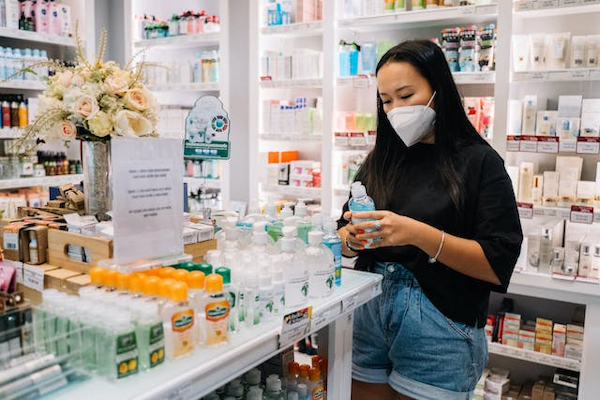SEJournal Online is the digital news magazine of the Society of Environmental Journalists. Learn more about SEJournal Online, including submission, subscription and advertising information.
 |
 |
| The Food and Drug Administration has issued a proposed rule cracking down on hair straighteners that release formaldehyde, but regulations don’t fully protect people from toxic cosmetics. Photo: Anna Tarazevich from Pexels. |
TipSheet: Personal Care Products — Bringing the Problems Home
By Joseph A. Davis
Most of us have wondered about, or even worried over, the unpronounceable ingredients listed on beauty and self-care products and the like. That is if we can actually read the tiny type.
It’s not a new concern, and it impacts a broad population. But few have reported on the local stories that connect people on the ground to this set of environmental health threats.
One exception is a recent reporting project by Victoria St. Martin at Inside Climate News that aims to encourage Black women to reexamine the harm from such products on their health.
This TipSheet will likewise try to help journalists find the local angle on this environmental and public health problem.
Why it matters
Cancer is one reason why this issue matters.
For example, hair straighteners used by some women contain formaldehyde, a chemical that causes cancer.
There is a universe of chemicals
that can cause harm in all kinds
of personal care products.
And there is a universe of other chemicals (e.g., skin lighteners that contain mercury) that can cause harm in all kinds of other personal care products.
The harms go beyond cancer. What’s worse, there is very little awareness (much less any effective regulation) of the problem.
The backstory
Theoretically, at least, these types of products are supposed to be regulated under the Food and Drug Act, first passed in 1906 as the Pure Food and Drug Act, during the heyday of progressive muckraking.
Amended many times over the years, it is today the Federal Food, Drug, and Cosmetic Act. But it still doesn’t fully protect people from toxic cosmetics. Well, at least they took the cocaine out of Coca-Cola.
There has long been a federal agency (known since 1930 as the Food and Drug Administration) to carry out the law. But the FDA’s regulation of cosmetics has been somewhat tepid.
Most recently, though, the agency issued a proposed rule cracking down on hair straighteners that release formaldehyde. But it doesn’t take effect until April 2024.
Find more information on this from the FDA via this cosmetic product update and this consumer fact sheet. The U.S. Environmental Protection Agency and the Occupational Safety and Health Administration regulate other aspects of toxic cosmetics.
Also, in 2022, Congress passed the Modernization of Cosmetics Regulation Act. The question now is whether cosmetics will be more tightly regulated. It’s still a bit early to answer that question. We’ll see.
In any case, you might want to reconsider that appointment for a Brazilian Blowout.
Story ideas
- Visit local salons: In many communities, you will find salons for hair, nails, etc. In fact, such salons (like barber shops) often actually are the community. They will vary a lot according to who lives in your community (ethnic and socioeconomic groups, etc.). Visit a bunch of them and talk to both patrons and technicians. Look at whatever take-home products they might be selling. Ask them if they have a material safety data sheet.
- Check in with state licensing bureaus: Most states require salon operators to be licensed. Talk to whomever you can at your state licensing agency and ask about its standards and policies on the toxicity of personal care products. You can find a list of state agencies here. Ask whether they have reciprocity with other states.
- Visit cosmetology schools: There are many cosmetology schools, and they are woven into the fabric of local communities and industries. For example, you might find some at community colleges. Pay a visit, talk to teachers and leaders, and ask what they teach about protecting both clients and operators from toxic substances.
- Consider occupational health: Whatever the risks to customers, beauticians have it worse. They are exposed to harmful chemicals all day and may be breathing the fumes in close quarters. Nail care technicians, for example, will be breathing toxic acetone and many other chemicals. Are there any occupational health rules? Talk to local operators and ask what they do to protect themselves.
Reporting resources
- Food and Drug Administration: The federal agency tasked with regulating cosmetics. Start here to find out more.
- Occupational Safety and Health Administration: OSHA is supposed to regulate these problems, but it can be hampered by the fact that many beauty operators are independent contractors who rent booths. Check this all-purpose safety plan, under its OSHA Fast Fix program.
- Environmental Working Group: This environmental advocacy group has specialized in information about toxic personal care products. Check its Skin Deep® database and EWG VERIFIED® product safety ratings.
- Personal Care Products Council: This is a trade group that lobbies on behalf of the industry. It’s got info on cosmetics and personal care products.
Joseph A. Davis is a freelance writer/editor in Washington, D.C. who has been writing about the environment since 1976. He writes SEJournal Online's TipSheet, Reporter's Toolbox and Issue Backgrounder, and curates SEJ's weekday news headlines service EJToday and @EJTodayNews. Davis also directs SEJ's Freedom of Information Project and writes the WatchDog opinion column.
* From the weekly news magazine SEJournal Online, Vol. 9, No. 2. Content from each new issue of SEJournal Online is available to the public via the SEJournal Online main page. Subscribe to the e-newsletter here. And see past issues of the SEJournal archived here.












 Advertisement
Advertisement 



